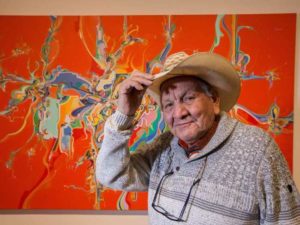Prolific painter’s solo exhibition on display at the National Gallary

By Suzanne Keeptwo
OTTAWA—Alex Janvier’s solo exhibition, spanning a lifetime of creativity, opened with fanfare at the National Gallery in Ottawa on November 24. There were customary speeches by the artistically and politically correct, including Indigenous Affairs Minister Caroline Bennett and Kirby Whiteduck (Pikwaganagan). But, it was the next day, at the Wabano Centre for Aboriginal Health where the artist conversed about his journey through residential school to a local crowd. Much of his paintings are politically charged commentaries about colonization and the policies of assimilation.
From Cold Lake First Nation (AB) of Dene Suline and Saulteaux ancestry, at eight-years-old, Alex was uprooted to attend the Blue Quills Catholic Residential School. There are reoccurring figures in much of Janvier’s work, faceless copies of each other as IRS students. His “Apple series” visually explains how kids going into the school, were green. Then, like in a factory, turned out red as per the insult hurled at the visibly Native who embrace white values. That was the intention of the schools. It didn’t necessarily work.
Janvier’s Indian Mother with Crying Boy (1968) clearly depicts the profound impact of the IRS.
“There was no culture involved. It was not relevant to our people. We didn’t get much of an education. We prayed so much we had blood on our knees,” stated Janvier.
His celebrated Our Lady of the Teepee (1952) painted when Alex was 15-years-old, first upset school staff because of blended religious images with that of Indigenous culture.
“In a rebellious way,” the artist admits. “I added the Indian stuff.”
That piece eventually received recognition at the International Vatican Exhibition in Rome.
The prolific painter gives credit to the elderly ladies of his youth, watched carefully as they did their bead and quill work.
“The Residential school was a confusing place,” stated Janvier. “My Elders lived off the land; they studied the land because their survival was based on that. Most importantly was the spiritual side of the Elders, informing us. So, every part of the shoreline is like a classroom with each season representing a different lecture.”
The 81-year-old artist talks about how the Indian Agent controlled all on the reserve, including denying his successful application to attend prestigious art schools in both England and Toronto. He was told “you’re not intelligent enough to go to those schools”. Instead, he was registered at The Alberta School of Art & Design. But the agent could not control how the talented youth made art.
“The only thing that helped me was the paintbrush,” recalled Janvier. “It was the only weapon I could use.”
He graduated with honors in 1960 and became an instructor at the University of Alberta.
In 1965, a stopover in Ottawa en route to New York landed him a job as advisor for the Indian Pavilion for Expo ’67 in Montreal. He served with others including the late Algonquin Chief turned Spiritual Leader, William Commanda (Kitigan Zibi) who “provided insight and information about eastern Canada. We were all suffering; it didn’t matter what part of the country you came from.”
In his painting Eagle Clarion (2003) the artist, who returned to a traditional life and continues to paint on his reserve, explains “the eagle is telling our people to go back to the traditional ways…to become who we are again.” He tells the crowd how he “would like our leaders to become strong again. It’s time for us to stand up for things that are important for our spirit, mind, bodies and culture.”
Alex Janvier’s art has been described as beautiful, elegant and intelligent. It’s largely abstract, often circular, definitely colourful and very contemporary, drawing from his subconscious. Alex has admitted “when I get angry, I can do beautiful things”.
“Keep painting. Don’t die,” stated Janvier when asked for advice to young artists. “The world needs you and the world needs your art. The world needs to see itself though your eyes.”
His work is on view in Ottawa until April 17, 2017.

